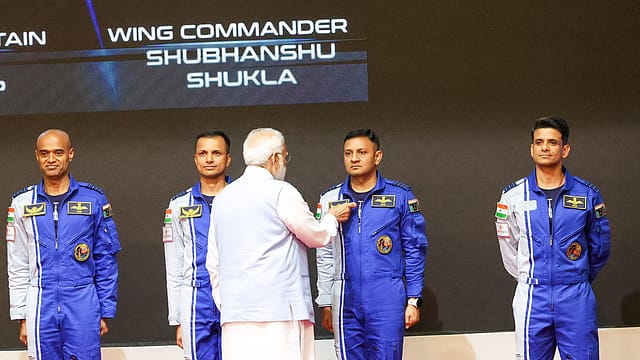Gaganyaan Mission: PM unveils astronauts’ names for India’s 1st human space flight
ADVERTISEMENT

PM Modi today announced the names of four astronauts for India's ambitious 'Gaganyaan Project', which are Group Captain P Balakrishnan Nair, Group Captain Ajit Krishnan, Group Captain Angad Pratap, and Wing Commander S Shukla. PM announced these names at the Vikram Sarabhai Space Centre (VSSC) near the Kerala state capital.
The Prime Minister visited the VSSC in Thiruvananthapuram, Kerala, and unveiled three significant space infrastructure projects with an estimated value of approximately ₹1,800 crores.
"The projects include the SLV Integration Facility (PIF) at the Satish Dhawan Space Centre, Sriharikota; the new ‘Semi-cryogenics Integrated Engine and Stage Test facility’ at ISRO Propulsion Complex at Mahendragiri; and ‘Trisonic Wind Tunnel’ at VSSC, Thiruvananthapuram. Modi also reviewed the progress of the Gaganyaan Mission," the statement issued by PMO states.
The Gaganyaan project aims to showcase the capability of human spaceflight by sending a crew of three members into a 400 km orbit for a three-day mission, ensuring their safe return by landing in the waters of the Indian sea.
On February 4, the Department of Space revealed the Woman Robot Astronaut ‘Vyommitra’ is set to venture into space ahead of ISRO's "Gaganyaan" mission, marking India's inaugural manned spaceflight with Indian astronauts. Making the announcement in New Delhi during a media interaction, Dr. Jitendra Singh, Union Minister of State (MoS) (Independent Charge) for Science & Technology; MoS PMO, Personnel, Public Grievances, Pensions, Atomic Energy, and Space, stated that the uncrewed ‘Vyommitra’ mission is slated for the third quarter of this year, while the manned mission "Gaganyaan" is scheduled for launch in the subsequent year, 2025.
January 2026
Netflix, which has been in India for a decade, has successfully struck a balance between high-class premium content and pricing that attracts a range of customers. Find out how the U.S. streaming giant evolved in India, plus an exclusive interview with CEO Ted Sarandos. Also read about the Best Investments for 2026, and how rising growth and easing inflation will come in handy for finance minister Nirmala Sitharaman as she prepares Budget 2026.
This ‘Female Robot Astronaut’ possesses the capability to monitor module parameters, issue alerts, and carry out life support operations. It is adept at performing tasks such as managing six panels and responding to queries, as stated by the official.
He went on to explain that the ‘Vyommitra’ Astronaut is crafted to emulate human functions in the space environment and engage with the life support system.
In October last year, PM Modi commended the successful launch of the Mission Gaganyaan TV D1 Test Flight, expressing that it brings the nation a step closer to achieving India's inaugural human spaceflight program.
PM posted on X, “This launch takes us one step closer to realising India’s first human space flight program, Gaganyaan. My best wishes to our scientists at ISRO.”
"As India is set to become the top-3 economy of the world, at the same time the country's Gaganyaan is also going to take our space sector to a new heights," PM posted via X.
In another statement released in the October month of last year, the Department of Space (DoS) highlighted that 20 significant tests, including three uncrewed missions of the Human Rated Launch Vehicle (HLVM3), were being planned. The meeting assessed the mission’s preparedness, confirming its scheduled launch in 2025.
“Building on the success of the Indian space initiatives, including the recent Chandrayan-3 and Aditya L1 Missions, Prime Minister directed that India should now aim for new and ambitious goals, including setting up ‘Bharatiya Antariksha Station’ (Indian Space Station) by 2035 and sending first Indian to the Moon by 2040,” it added.
